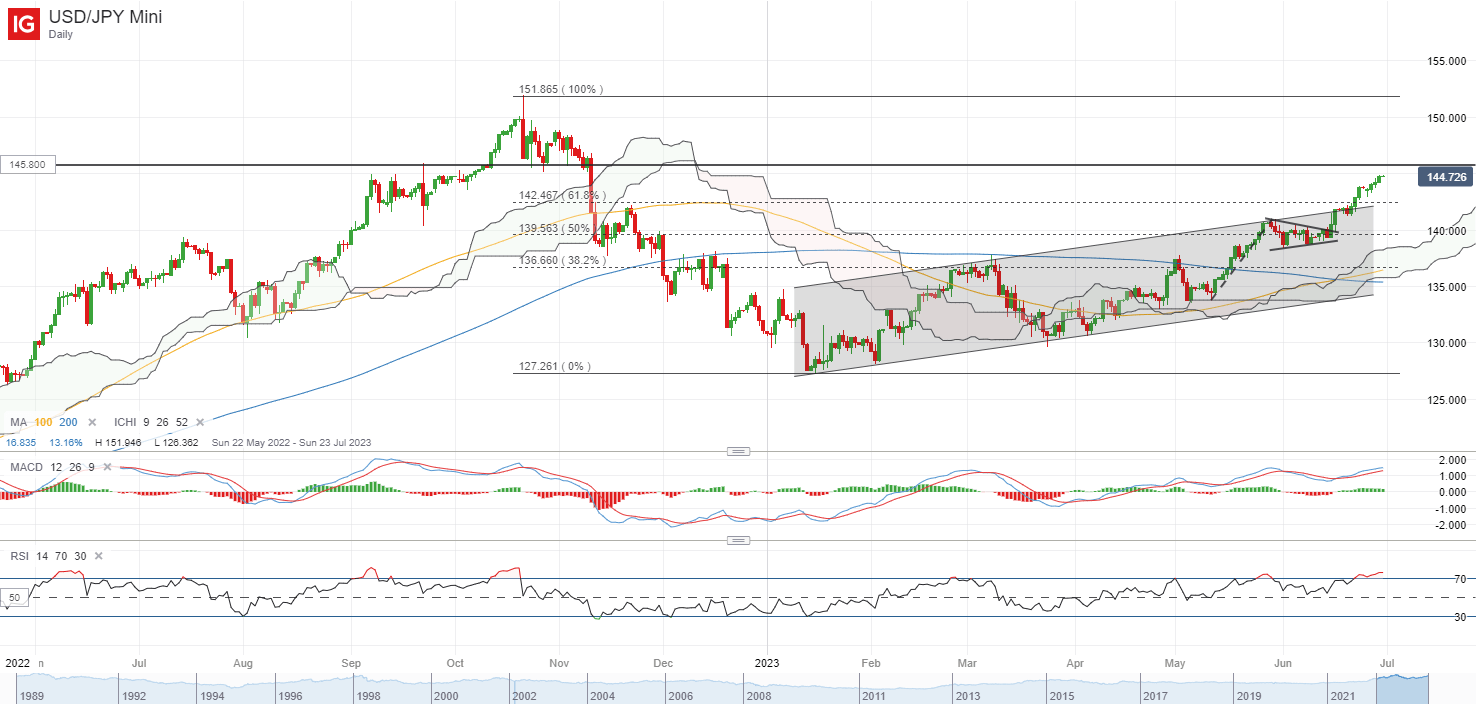The big upward revision in the final reading of US GDP data for the first quarter (2.0% vs. 1.4% expected) adds to the list of positive economic surprises in the US lately, with economic resilience helping to calm some nerves about recession fears, at least for the time being. . That set the stage for a catch-up performance in riskier small-cap stocks overnight, with the Russell 2000 outperforming its peers to close up 1.2%.
Banking stocks also stole the spotlight, with all 23 lenders excelling in the Federal Reserve’s (Fed) annual stress test by proving their resilience in the face of a severe recession scenario. The results provided a positive prelude to their earnings releases within a few weeks, which saw renewed market appeal over the prospects of higher payout for shareholders.
So far, the SPDR Financial Sector Fund has yet to fully recover from pre-SVB levels, with the index trading within a rising wedge pattern in its wake. The Relative Strength Index (RSI) managed to hold above the 50 level, keeping the near-term bias to the upside. The next test for buyers will be at 33.70-33.90, which is a resistance confluence area, especially from the 200-day moving average (MA) and upper wedge trendline resistance. A break above this level could pave the way towards the next 35.00 level.
Source: IG Charts
Treasury yields jumped as interest rate expectations saw an optimistic recalibration in the wake of a brighter picture for the US economy. Two-year yields rose nearly 15 basis points to a new three-month high, while the 10-year also saw a similar move to retest last June’s high, while keeping a lid on the interest rate-sensitive Nasdaq.
The next day will leave all eyes on the release of the core PCE price index in the US later today. Being the Fed’s preferred measure of inflation, inflation data hasn’t seen much progress since the beginning of the year, unlike the US Consumer Price Index (CPI). Another batch of stubborn inflation reading could bolster interest rate expectations for a longer period and reverse interest rate cut expectations, which have been underlined by signs of US economic strength recently.
Asian Open Championship
Asian shares seem poised for a pessimistic opening, with Nikkei -0.69%, ASX -0.38% and KOSPI +0.14% at the time of writing. Despite the recent stoking of currency intervention by the Japanese authorities, doubts remain very much about any follow-up action as USD/JPY has continued to rally over the past week, along with the strength of the US dollar. The pair is only 0.5% away from the level of 145.80, where a softer round of yen buying (19.7 billion USD) took place in September 2022, which failed to provide much conviction to the markets at that time.
This morning, a lower-than-expected Tokyo core CPI (3.2% vs. 3.3% expected) is likely to reinforce the Fed-BoJ’s policy divergence once again and add downward pressure on the JPY. We may witness a further escalation of intervention talks by the Japanese authorities in the future, but unless it is translated into concrete actions, it may seem difficult to stop the increase in the pair. Even in the event of intervention, the attempts of 2022 indicate that the volume of yen buying is important.
USD/JPY will face a key test of resistance at 145.80, as caution may grow over intervention possibilities while technical conditions are heading in the overbought territory. But given the higher highs and lower lows since the beginning of the year that have pinned an uptrend in place, any sell-off could still be seen as a retracement, leaving 142.50 in check for immediate support.
Source: IG Charts
In the future, NBS China PMI numbers will be on the radar. The softer reading in the June PMI numbers remains the broad consensus (49 vs. 48.8 prior), which is likely to reinforce views that more needs to be done. A continual shift in the data would be warranted to provide greater conviction that the worst is over.
ON WATCH LIST: The US dollar is being watched ahead of the release of the US core PCE price index
The US dollar has rallied in the run-up to today’s US PCE release, benefiting from some resilience in Treasury yields recently as positive economic surprises this week point to expectations of higher interest rates for longer. The 100-day MA recovered overnight, after it received support from the Ichimoku Cloud on the daily chart. Buyers are also seeking more control, with a bullish cross on the MACD and a move in the RSI back above 50, but validation should be sought from a steadier set of inflation readings to support further USD strength.
103.12 could act as immediate resistance to overcome, with a move above this level likely paving the way for a retest of 105.00 next. On the other hand, failure to regain the level could leave the lows since 2023 in check at the level of 100.50.
Source: IG Charts
Thursday: DJIA +0.80%; S&P 500 +0.45%; Nasdaq -0.02%, DAX -0.01%, FTSE -0.38%

